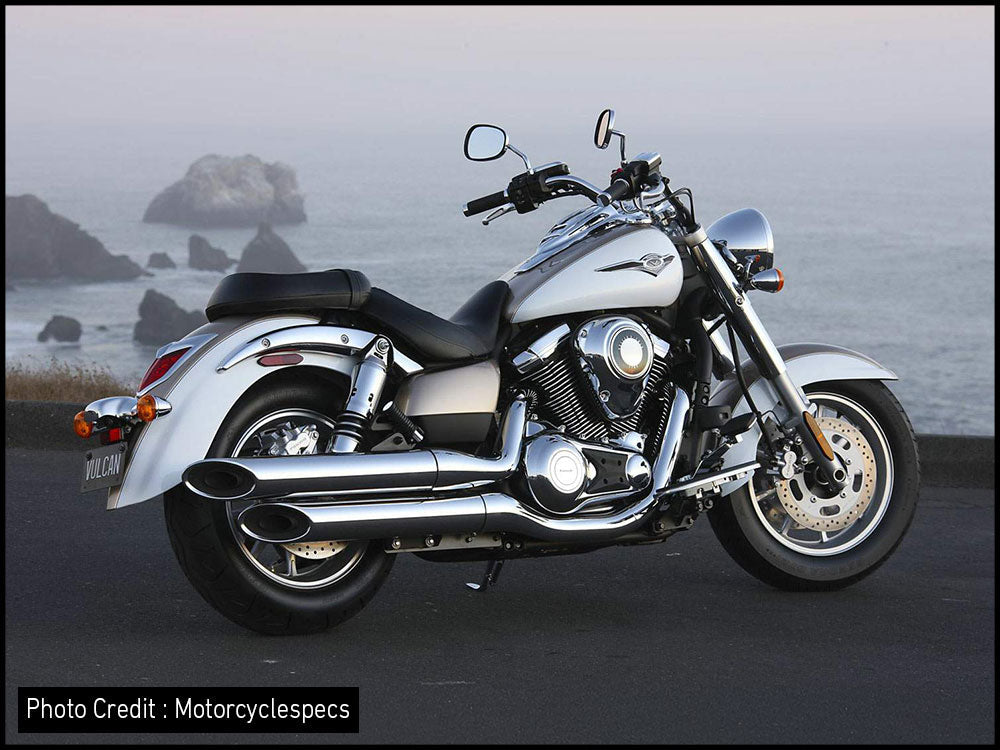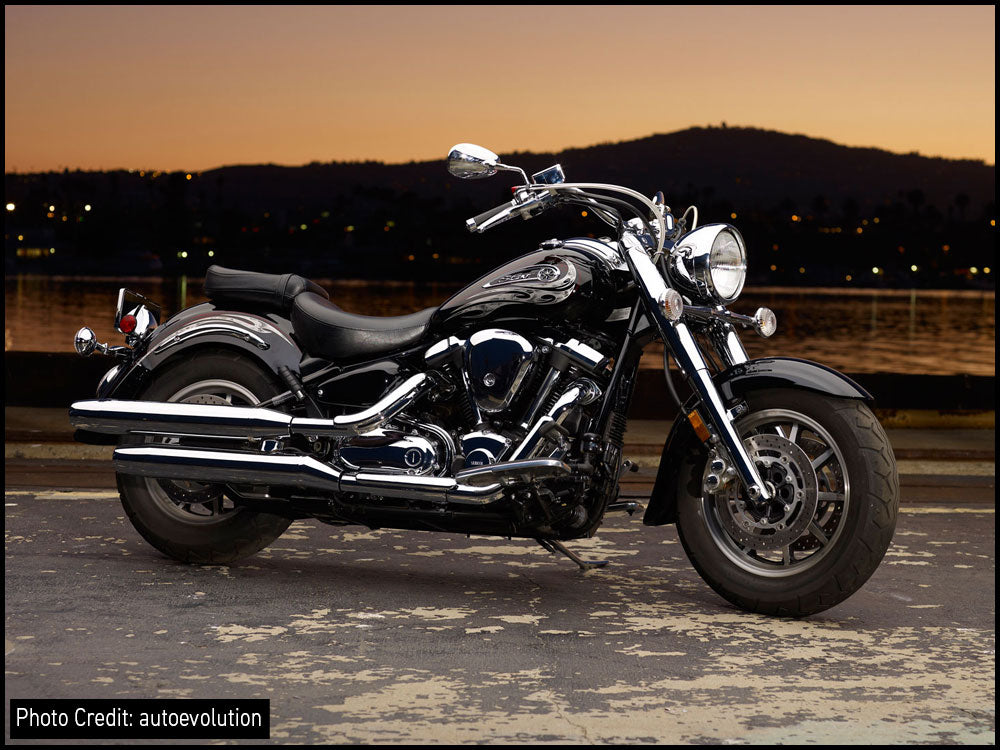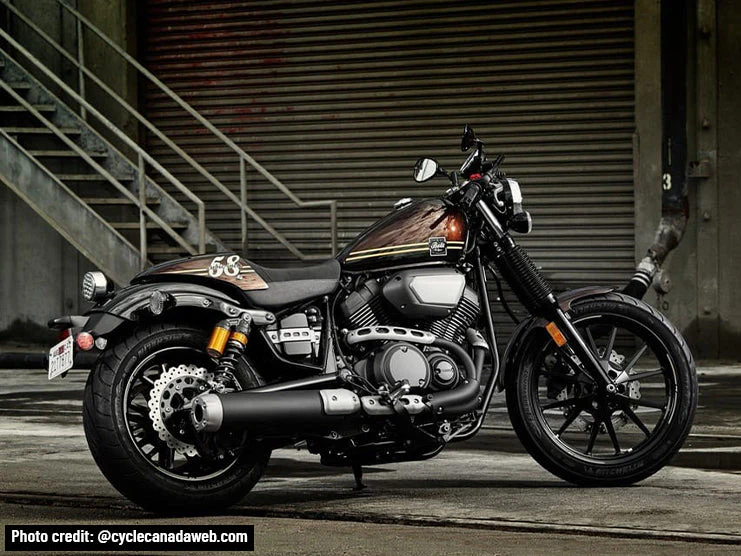Table of Content
Kawasaki has been using the Vulcan logo to represent its motorcycle cruiser brand since 1984. This Japanese motorcycle company is known for producing some of the best motorcycles in the world. This brand represents Japanese innovation and ingenuity, and it is still a top contender in the motorcycle business today.
If you are a fan of cruiser-type motorcycles and looking for a comfortable cruiser with a large engine displacement, curved appearance, fat tires, and modern features, Kawasaki has the motorcycle for you. The Vulcan 1700 Classic, VN1700 is a motorcycle built for cruising boulevards with the low-down punch and power you'd expect from a large-capacity custom.
Here is a post dedicated to this gorgeous machine, the Kawasaki Vulcan 1700 Classic. Jump down to read the background, performance, detailed specs, and more about this bike.
1. A Brief History Of Kawasaki Vulcan 1700 Classic
The Vulcan line represents the cruiser-type motorcycle built by Kawasaki in 1985. The Vulcan chain showed up in the market with the release of the Vulcan 750 and then became a steadfast model for the company. Kawasaki expanded the Vulcan line with different sizes ranging from 500cc to 2053cc. Unluckily, the United State raised the import restrictions on imported motorcycles that displace more than 700cc just after the release of the original 750 Vulcan. To maintain its presence in the market, Kawasaki reduces the motor of its original Vulcan and sell it with a 699cc engine capacity. Afterward, they undid the changes when the restrictions expired in 1986. This mechanical horse was based on a V-twin, liquid-cooled engine and stayed in production until 2006.
Afterward, Kawasaki updated the Vulcan line with another model (the smallest in line), the VN500 in 1990. This model proved its presence as a beginner-level motorcycle and was based on a 498cc, air-cooled, parallel-twin engine. The unit was lucky enough to stay in line until 2009. Kawasaki continued to write the history pages for the 1990s with two more models, the 800 Vulcan and the 1500 Vulcan. However, the 1500cc Vulcan was awarded as the first bulky cruiser from the company and was muscled by a 1470cc liquid-cooled, V-twin, SOHC engine. This machine enjoyed a production run until 2008.
The year 1999 had a positive impact on Kawasaki's way of redecorating antiquity. By that time the Japanese company had introduced the Vulcan Drifter with the same displacement of 1500ccs. On this take, the company fit the bike with large fenders which are obvious signs of its design influence. The Vulcan Drifter was based on a V-twin 1470cc liquid-cooled engine until its rebadging with the Drifter 800 in 2000. After being merged into a smaller displacement it continued to grace showroom floors until 2006.
The Vulcan line again received an upgrade with the starting of a new century and meeting with much success with the addition of new units in line, the Vulcan 2000, the Vulcan 1700, the Vulcan 1600, and the Vulcan 900. However, the 1600 Vulcan was aided with a liquid-cooled, 1552cc V-twin, SOHC engine and was designed in three variants.
| No. | Name |
|---|---|
| 1. | Mean Streak |
| 2. | Nomad |
| 3. | Classic |
The 2002 Vulcan 1600 gave its designation to the Kawasaki 1700 Vulcan. 2009 was the year of 1700 Vulcan when it was accompanied by a mighty displacement engine combined with A six-speed transmission. Kawasaki charted the 1700 Vulcan in four different models. Luckily this model got loved enough to stay current in production.
Kawasaki Vulcan 1700 Models:
| No. | Name |
|---|---|
| 1. | Standard |
| 2. | Classic |
| 3. | Nomad |
| 4. | Voyager |
2. A Quick Look At Kawasaki Vulcan 1700 Classic, VN1700

2.1. Overview
Upon looking at the 1700 Classic Vulcan, you'll understand why Kawasaki is famous for providing its customers the power, rideability, and style. This machine is loaded with a 1700 cc, V-twin, SOHC, liquid-cooled engine and powered by a six-speed transmission. At 5000 rpm it provides a peak power of 55 KW and a torque of 135 Nm at 2750 rpm.
An electronic throttle valve system is added to the engine which allows the control unit to handle the amount of both air and fuel flowing into it. Moreover, this muscular machine comes standard with a 20-liter fuel tank, disc brakes at the rear and front, and an electronic cruise control system.
2.2. Kawasaki Vulcan Classic 1700 Features And Benefits
Kawasaki Vulcan 1700 Classic Mighty Engine
The VN1700's V-twin long-stroke, SOHC, eight-valve 1,700 cm^3 liquid-cooled engine was built to deliver the high-end torque, and its valve system being based on the VN2000. The SOHC arrangement is used in the place of OHV to increase direct engine feel and better cruising on highways.
Kawasaki Vulcan Classic 1700 Cruise Control System
The Vulcan 1700 Classic features an electronic cruise control system that allows you to maintain engine RPMs (speed) with the push of a button. This system enables easy cruising for the rider to give the freedom of not adjusting the throttle constantly. When traveling long distances, this reduces the continuous functionality of the right hand while relieving stress and increasing the riding pleasure.
Kawasaki Vulcan 1700 Classic Electronic Throttle Valve System
Its electronic throttle control system facilitate the engine by allowing the control unit to manage the amount of air and fuel flowing into it. The ideal combination of throttle valve placement and fuel injection ensures a natural and smooth response. This combination also control the idling speed of a cold engine with precission.
Kawasaki 1700 Classic Belt Drive
Its belt final drive is smooth, quiet, and efficient, meaning that this component is low maintenance. The belt offers improved tensile strength by 40% with a small size and a low weight thanks to the carbon fiber material.
Vulcan 1700 Classic Gear Transmission & Overdrive Gear
The Kawasaki VN1700's sixth gear is an overdrive gear that was added to provide improved fuel economy and restful riding when cruising at boulevards.
Vulcan Classic 1700 Tank Mounted Instruments And More
The tank-mounted instrument cluster is designed with a multi-feature LCD and a convenient ignition switch. The displays on the LED are operated by switches fitted on the handlebar on the right side. It includes the features like a fuel gauge, odometer, average fuel consumption, gear position display, clock, and dual trip meters.
The interesting fact about the ignition switch is it allows for key removal in the ON position. This feature is added to prevent key rings from damaging the tank or instrument assembly while the bike is running. When the ignition switch is turned to the OFF position the engine is turned off and if you want to restart the engine you must need to re-insert the key.
Kawasaki Vulcan 1700 Classic Fuel Tank
The VN1700's curved profile is fitted with an attractively shaped fuel tank, which tapers at the back and flows through the rest of the bike. The fuel tank's curves have continually changing radii, giving the bike a powerful and alluring dynamic.
Kawasaki Vulcan 1700 Classic LED Taillight
The VN1700 is the first cruiser in the Kawaski line-up which came with an elegant LED taillight.
Vulcan 1700 Classic Rear Suspension
The Vulcan 1700 Classis's dual adjustable rear shocks are responsible for providing a comfortable feel and feature chromed shock covers, ensuring a luxury finish at the rear of the bike.
Kawasaki Vulcan 1700 Classic Braking System
The VN1700 is loaded with an advanced anti-lock braking system known as K-ACT ABS. This system is built to hold the tires from locking up when the brake applies. Ultimately this system (K-ACT ABS) was only built for touring models having an excess weight of more than 300 kg ( a weight excluding the passenger rider and luggage).
This braking system connects both brakes (front and rear) on top of the regular ABS function. It keeps track of the riders front and back braking force, as well as the bike speed, to enable extremely powerful braking while keeping the chassis in a stable form.
Let's imagine the rider applying pressure to the lever of the front brake, the system activates the rear brake through fluid pumps to keep the bike protected from tilting forward and maintain overall balance. When the rider applies the rear pedal, the braking system also activates the front brake to divide the load equally and prevent the back wheel from locking up. K-ACT determines the best hydraulic pressure that transmits to each wheel based on the vehicles speed.
3. Kawasaki Vulcan Classic 1700: A Buyer's Guide
3.1. What is the Top Speed of a Kawasaki 1700 Vulcan?
The Vulcan 1700 is powered by a 1700 cc, liquid-cooled, four-stroke, V-twin, SOHC, eight-valves engine. It is estimated that this bike can reach up to 149 mph.
3.2. Does Kawasaki Vulcan 1700 Classic Have Cruise Control?
Yes, the Vulcan 1700 Classic has electronic cruise control that gives you the benefit of maintaining the speed with the push of a button. When traveling long distances, this reduces the continuous functionality of the right hand while relieving stress and increasing the riding pleasure.
3.3. How Heavy is a Kawasaki Vulcan 1700 Classic?
The Classic VN1700's curved profile is aided by the attractive fuel tank, which tapers at the back and flows through the rest of the bike. It is estimated this bike weighs around 345.2 kg (761.0 lbs ), including oil, gas, etc.
4. Detailed Specifications (Kawasaki Vulcan 1700 Classic, VN1700)
4.1. Frame, Suspension, Wheels, & Brakes
| Type | Steel frame, double-cradle desgin with box-section single-tube backbone |
| Rake | 30.0° |
| Trail | 169 mm (6.7 in) |
| Front Suspension | 5.5 in / 43mm - hydraulic fork |
| Rear Suspension | 3.1 in / Swingarm with dual air-assisted shocks having 4-way rebound damping |
| Tire (Front) | 130/90 x16 |
| Tire (Rear) | 170/70 x 16 |
| Brake (Front) | Double disc. Two-piston calipers |
| Diameter (Front Brake) | 11.8 in (300 mm) |
| Brake (Rear) | Single disc |
| Diameter (Rear Brake) | 11.8 in (300 mm) |
4.2. Engine & Transmission
| Engine | V2, four-stroke |
| Cubic Capacity | 1700.0 ccm - (103.73 cu in) |
| Power | 73.8 HP (53.8 kW)) @ 5000 RPM |
| Torque | 146.5 Nm (108.0 ft/lbs or 14.9 kgf/m) @ 2250 RPM |
| Compression | 9.5:1 |
| Bore & Stroke | 4.0 x 4.1 in (102 x 104 mm) |
| Valves Per Cylinder | 4 |
| Fuel System | Digital fuel injection, twin 42mm throttle valve bodies |
| Fuel Control | (SOHC) Single Overhead Cams |
| Lubrication System | Forced lubrication, semi-dry-sump |
| Cooling System | Liquid |
| Ignition System | Digital Advance with TCBI |
| Clutch | Manual - Wet multi-disc |
| Transmission | Belt drive |
| Gearbox | Six-speed |
4.3. Dimensions & Capacities
| Fuel Capacity (Max) | 20.06 liters (5.30 US gallons) |
| Seat Height | 719 mm (28.3 in) (Lowest setting if adjustable) |
| Overall Height | 45.5 in (1156 mm) |
| Overall Length | 98.4 in (2499 mm) |
| Overall Width | 40.4 in (1026 mm) |
| Ground Clearance | 5.1 in (130 mm) |
| Wheelbase | 65.6 in (1666 mm) |
| Wet Weight | 345.2 kg (761.0 pounds) |
4.4. Additional Specs
| Starter | Electric |
| Color Option | Ebony |
| Year | 2014 |
5. Customization And Aftermarket Parts For Kawasaki Vulcan 1700 Classic, VN1700
Kawasaki designed the Vulcan 1700 Classic with cruising comfort and modern features. This stunningly beautiful cruiser evokes a certain feeling in riders: one that calls you aboard with its magnificent curves and drop-dead custom style that says, “Let’s ride.” The 1700 Classic is beautiful from every angle - from its slanted front end to the fat rear fender.
Admires of the 1700 Vulcan always adore its paint job, heavy chrome plating, and attention to detail, always wanting to keep this beauty in clean condition. Many riders want to make it more comfortable and suited to their lifestyles by adding desired parts like handlebars, crash bars, luggage racks, rider passenger backrests, fairings, and more.
Put your gloves and helmet on, jump on the seat, grab the stunning handlebars, and you are ready to go for your adventure tours on your Vulcan 1700 Classic. But before departing, make sure that you’ve filled the luggage bags for keeping all the stuff you’ll need while touring and attach a good quality sissy bar for back support.
You also have the option to choose a more comfortable seat over an old one and can add a rider passenger seat to travel with your friends and loved ones.
To add more class to the classic looks, attach a set of high quality saddlebags to carry your daily essentials and more.













Leave a comment
All comments are moderated before being published.
This site is protected by hCaptcha and the hCaptcha Privacy Policy and Terms of Service apply.